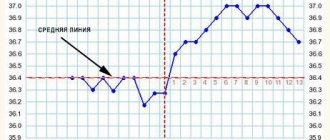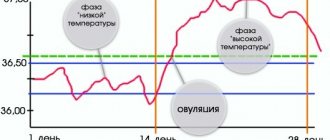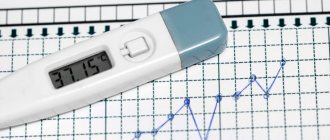Basal temperature during menopause (BT) can show whether there are hormonal disorders in the female body. BT serves as an important preventive measure in order to exclude various pathological processes in the reproductive system. There is a sad pattern that in women during menopause after 50 years, the activity of the gonads fades, which entails serious changes in hormonal levels and the development of new diseases, the presence of which was not previously noticed.
What body temperature should be during menopause?
The human body temperature is normally set at 36.6 C, but throughout the day it can rise by several degrees. Doctors believe that if the body is in full health, an increase in temperature to 370C is acceptable.
During menopause, several key events occur: a woman’s childbearing age ends, the hormonal function of the ovaries ceases, the body adapts to the changes that have occurred and begins to work in a new way. Therefore, many ladies are interested in whether the temperature can increase during the restructuring of the functioning of the female body and by how much degrees.
As a rule, body temperature during menopause becomes changeable. In the morning, when the woman’s body has just woken up, the lowest temperature is observed - 36.6 mC. By evening the temperature rises to 37-37.5 C.
In this case, the lady may feel general weakness, but there will be no sensations of weakness or aches in the body, which are present during the development of a cold or other diseases.
Thus, to the question of whether there is a temperature during menopause, the answer will be in the affirmative. It increases under the influence of menopause manifestations.
Daily routine and diet
To ease the symptoms of menopause, it is imperative to normalize your daily routine and improve your diet. A woman should:
- sleep fully, give the body rest;
- do not include spices, marinades, or fatty foods in the menu;
- take multivitamins;
- exercise daily.
If the patient adheres to all of the above recommendations, then the menopausal period will pass without any unpleasant symptoms.
At the stage of menopause, the body's alarm signals cannot be ignored. If there is a regular increase in temperature or other suspicious phenomena, you should consult a medical specialist. This will prevent the development of serious pathologies.
What indicators are the norm?
Basal temperature refers to the local temperature inside the vagina. It depends on the health of the woman’s reproductive system. The graph of its values displays all the changes occurring in the system - phases of the menstrual cycle, illness, and pregnancy. Fluctuations in the indicator depend on the level of progesterone.
The values in the first phase of the menstrual cycle, when the hormone estrogen dominates, are set at 36.2-36.6 C. Before ovulation, a jump occurs to a value of 36.7-37.2 C.
During menopause, there is no longer a jump in temperature, as during reproductive age.
After ovulation, when the level of the hormone progesterone increases, the indicator remains between 36.7-37 C. About a day before the start of menstruation, the value drops to the original figures.
Basal temperature during menopause will have different indicators. At the premenopausal stage, a woman still gets her period, but ovulation occurs less and less often due to the fact that the supply of eggs has been depleted. It is formed during the prenatal development of a girl. If there is no ovulation in the middle of the cycle, there will be no obvious temperature changes.
Basal temperature during menopause and postmenopause will remain at the same level. It is impossible to answer unequivocally what temperature during this period may be normal for a particular woman. In most cases, it stays at around 37 C. But due to the characteristics of the body, in some ladies it may be slightly lower.
Read more about the meaning of BT
Basal temperature depends on the state of the reproductive system. The indicator values reflect any changes occurring in it: the stage of the menstrual cycle, pregnancy, illness. And although additional research is needed to determine their causes, it can suggest the presence of some kind of trouble.
To obtain clear information, BT measurements should be carried out regularly. It is not enough to know its meaning only during the month. This also applies to the reproductive period. But when basal temperature is needed during menopause, doctors insist that it makes sense to keep the chart for a long time. Including indicators for the days of the cycle, it will show the increase-decrease, difference from normal values or compliance with them.
Is it necessary to measure basal temperature during menopause?
Many women are interested in why they should plot their basal temperature during menopause. During reproductive years, it is used to calculate the days when it is impossible to get pregnant.
It is impossible to protect yourself in this way during the premenopausal stage, since the menstrual cycle often changes. After menopause, conception no longer occurs.
Expert opinion
Roman Andreevich
Candidate of Medical Sciences, gynecologist-obstetrician, 14 years of work experience.
To get a consultation
The fact is that doctors consider the menopausal period, in a sense, critical. Many women develop neoplasms, both benign and malignant. Various diseases of the reproductive and endocrine systems begin to develop.
It is hormonal changes that provoke changes in basal temperature.
If the basal temperature does not remain within normal limits, then its changes will help identify:
- beginning to fall asleep in the hormonal function of the ovaries;
- problems in the functioning of the female reproductive system;
- development of diseases of the genital area;
- the woman’s body’s reaction to hormone replacement therapy.
A graph of basal temperature indicators drawn up by a woman helps the gynecologist make a preliminary diagnosis for many diseases. From a simple inflammatory process to endometriosis, fibroids, hyperplasia and cancerous tumors. The development of such diseases is accompanied by an increase in temperature.
In addition, according to the schedule, the doctor will be able to see whether there is a need to prescribe hormone replacement therapy to the woman. Sometimes, a woman is only worried about dryness in the intimate area and psycho-emotional manifestations, which many are embarrassed to tell the doctor about. But if the basal rate rises, this means that the symptoms are affecting the body so much that they need to be eliminated.
After prescribing hormonal medications, the lady draws up a schedule so that the gynecologist can make sure that the prescribed drug, as well as its dose, are suitable for her. When the indicator increases while taking the drug, the doctor needs to adjust the dosage of the drug, and sometimes prescribe a new drug.
Why measure BT after the end of menstrual function?
A woman who has reached the age of menopause is unlikely to plan to become pregnant again. But you cannot protect yourself by identifying this indicator, since there is a high probability of error in determining safe days. So what does measuring BT in menopause give?
This age is in a sense critical. That is, it is fraught with the occurrence of many diseases of the reproductive sphere, endocrine, tumor. The discrepancy between basal temperature and normal values will help
- Identify the approach to menopause itself. If your periods come less frequently, you are about 45 years old, your health has changed, additional BBT measurements will help determine the beginning of a decline in ovarian function. Since premenopause can last for years, this will make it possible to control its progression;
- Find out about the negative changes that have occurred in the reproductive organs. Endometriosis, hyperplasia, fibroids, and cancerous tumors that become more active in some women or appear for the first time always give an increase in BT. Even simple inflammation due to a cold will affect its graph by increasing;
- Determine the need for hormone therapy to improve well-being during menopause. Her syndrome may have only some of the symptoms, for example, only dry mucous membranes in the intimate area or psycho-emotional manifestations, which not everyone attaches due importance. But if they have high BT values, this indicates a strong influence of these symptoms on the body and the need to eliminate them;
- Determine the body's response to hormone therapy. Not everyone to whom it is indicated and used tolerates these drugs well. When taking them, accompanied by increased BT, you may have to adjust the dosage or choose another remedy.
When is it important to know menopausal BT
Menopause increases the likelihood of illness for everyone. But basal temperature during menopause should be monitored especially carefully and for a long time by those who:
- Family history of cancer of the reproductive organs or mammary glands;
- At a young age there were difficult births, abortions, and other surgical interventions in the genital area;
- There were no pregnancies, childbirths, or lactation;
- There are chronic inflammatory diseases of the reproductive organs;
- Worrying about the severe manifestations of menopause;
- Bleeding occurs for unknown reasons.
How to measure correctly
The temperature indicator is subject to third-party influences, so to obtain reliable data it is necessary to strictly adhere to the procedure.
There are these rules:
- It is recommended to take the measurement in the morning immediately after waking up and before getting out of bed.
- It is advisable to carry out the procedure at the same time.
- Preference should be given to measuring in the vagina rather than under the tongue.
- It is necessary to take into account all the subtleties of the procedure. The thermometer can be anything - mercury or electronic. But it is important to use the same thermometer every day. The measurement is carried out in a lying position. The thermometer is inserted no more than 2 cm and held motionless for no less than 6 minutes.
- We must not forget about restrictions. 6 hours before the measurement you should not drink alcohol, eat, take contraceptives or have sexual contact.
The indicators are recorded, and when measurements are taken for 21 days, a graph is drawn up. If a woman is still menstruating, then in one menstrual cycle.
Who needs to build charts for a long time
It has long been recommended to measure basal temperature for women who are at risk for health problems during menopause:
- there are bleedings for unknown reasons;
- close relatives had malignant tumors of the mammary glands or organs of the reproductive system;
- there have been difficult births, miscarriages, abortions or other surgical operations on the uterus;
- the lady did not give birth or become pregnant;
- there is chronic inflammation of the genital organs.
If the indicator does not stay at the same level, and its values change frequently, then the woman should immediately consult a doctor. Such control makes it possible to detect diseases in the early stages.
Expert opinion
Alexandra Yurievna
General practitioner, associate professor, teacher of obstetrics, work experience 11 years.
In such cases, the treatment will last less time and will cost the lady less. And most importantly, the likelihood of a full recovery increases.
Reviews
I am 49 years old. When regularly measuring the temperature in the vagina, I began to notice its increase. I felt unwell and tired in the evening. I came to the gynecologist with a basal temperature chart. After an ultrasound examination of the uterus, endometriosis was discovered. Hormonal treatment was prescribed. Now the condition is normal.
After 56 years, I began to notice a disruption and cessation of the menstrual cycle. I consulted with my doctor about possible side effects. I was very afraid of hot flashes. The specialist said that it is possible to detect the onset of menopause and prevent complications by tracking hormonal processes by plotting the temperature of the pelvic organs. I followed all the doctor's instructions. The examination did not reveal any pathologies. I recommend this method to everyone.
A colleague said that during menopause you can get pregnant because the egg periodically matures. It is necessary to measure the temperature of internal organs. The method is very simple and affordable. I bought a special thermometer and measure my temperature every morning. I'm going to show the chart to the gynecologist.
What provokes an increase in the indicator
The temperature during menopause in women may increase for the following reasons:
- Tides. This specific symptom provokes a decrease in the amount of estrogen. For the thermoregulation center located in the hypothalamus, a decrease in the level of the hormone in the blood is a signal that the body is overheated. During menopause, estrogen levels decrease due to the gradual cessation of ovarian hormonal function. Having received a false signal, the thermoregulation center begins to fight the imaginary excess heat, and the lady feels hot flashes.
- Increased blood pressure. When a woman’s blood pressure rises sharply, her body temperature rises at the same time.
- Menstrual irregularities. The longer the delay in menstruation, the more emotional and physiological stress the female body experiences. As a result, the temperature may rise a few days before the next period.
- Pathological processes. When a woman of reproductive age had uterine fibroids or endometrial hyperplasia, then with the onset of menopause the disease can reappear. In this case, there will be an elevated body temperature for a long time.
Thus, increased temperature during menopause may accompany specific manifestations of this period. In such cases, there is no need to panic. If a high value on the thermometer is observed for a long time, then you should contact a gynecologist in order to diagnose the emerging pathology in a timely manner.
Reasons for jumps
Patients often ask their doctor whether there can be a fever during menopause.
There are a number of reasons for changes in temperature in menopausal women. Hormonal changes are accompanied not only by suppression of reproductive function. Estradiol (the main hormone) affects the activity of most vital systems.
- changes in endocrine adrenal function;
- disorders of carbohydrate and lipid metabolism;
- formation of atherosclerotic plaques.
Tides
Hypoestrogenism disrupts connections in the pituitary gland, which is responsible for thermoregulation of the body. Receiving false signals that the woman is hot, an attack develops. Her face turns red and she feels short of breath. The attack continues for 5-6 minutes. It ends with the appearance of profuse sweating and chills. The temperature may rise to 37.5 °C.
Chills during menopause, like tremors and hot flashes, are the main sign of the onset of age-related changes in the body. It may continue regularly for several minutes over a long period of time. Chills are not considered an anxiety syndrome, but it is necessary to properly respond to the pathological process. Cold flashes can be replaced by hot flashes.
They are also provoked by:
- excessive physical activity;
- mood changes;
- stress.
A low temperature can occur due to excessive drinking and smoking.
How is the treatment carried out?
Only a doctor can prescribe a course of treatment. Depending on the woman’s health condition and the course of menopause, a treatment option is selected. If the menopause is mild, the gynecologist prescribes products containing phytoestrogens - Remens, Klimaksan, Klimakt-Hel and others.
If menopause is severe, hormonal medications will be prescribed. For example: Klimonorm, Proginova or Klimen. All medications should only be prescribed by a doctor.
Self-medication can make the situation worse. It is very important to adhere to a healthy lifestyle: eat more plant foods, exercise regularly and walk in the fresh air, and also try to be less nervous.
Features of therapy
A decrease or increase in BT is the reaction of the female body to the manifestations of menopausal syndrome. The indicators are directly affected by hot flashes, insomnia, hypertensive crises, and depressed morale. Stabilizing basal temperature during the menopausal period is possible only with proven therapeutic methods, which can only be prescribed by the attending physician.
In general practice, the patient is first asked to undergo an examination to find out the cause of the jumps in basal temperature values. If a provoking factor is identified, the doctor prescribes treatment. It could be:
- taking hormonal medications under constant monitoring of blood clotting indicators, the health of the mammary glands and reproductive organs,
- therapy with drugs based on phytoestrogens,
- strengthening and restoring the body with the help of traditional medicine.
Women of menopausal age are advised to lead a healthy lifestyle, give up smoking and alcohol, exercise moderately and undergo preventive examinations in a timely manner, then the manifestations of menopause will be milder and will not harm the body.











